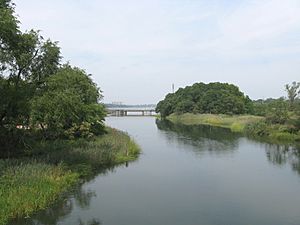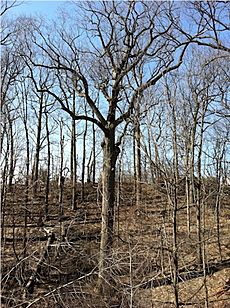Alley Pond Park facts for kids
Quick facts for kids Alley Pond Park |
|
|---|---|

Alley Pond Environmental Center (APEC)
|
|
| Type | Public park |
| Location | Bordering Douglaston and Bayside in New York City |
| Area | 655.294 acres (265.188 ha) |
| Operated by | New York City Department of Parks and Recreation |
| Status | Operating |
| Parking | 200 spaces |
Alley Pond Park is a huge public park in Queens, New York City. It's the second-largest park in Queens, covering about 655.3 acres (265.2 ha). That's a lot of space for nature and fun!
The park is surrounded by different neighborhoods and roads. To the east, you'll find Douglaston, and to the west is Bayside. Little Neck Bay is to the north, and Union Turnpike is to the south. Big roads like the Cross Island Parkway, Long Island Expressway, and Grand Central Parkway also pass through the park.
Alley Pond Park has different types of natural areas. South of the Long Island Expressway, you'll find thick woodlands. North of it, there are wide-open meadowlands. The park is managed by the New York City Department of Parks and Recreation, which helps keep it beautiful and safe for everyone.
One special thing in the park is the Queens Giant. This is a huge tulip poplar tree. It's the tallest carefully measured tree in New York City. It might even be the oldest living thing in the whole New York metropolitan area!
You can also visit the Alley Pond Environmental Center (APEC) in the northern part of the park. It has a library, a museum, and even animal exhibits. It's a great place to learn about nature.
Contents
What's the History of Alley Pond Park?
How Did Alley Pond Park Begin?
Long ago, the land that is now Alley Pond Park was home to the Matinecock Native Americans. They gathered shellfish from Little Neck Bay. English settlers started arriving in the 1630s. They built mills along Alley Creek and used the valley as a path to other towns.
This area became known as "the Alley" because it was a busy passage. Even U.S. president George Washington might have used this route in 1790! Later, a general store opened here in 1828.
In the 1800s, William Douglas bought land around Oakland Lake. This lake was named after a large estate called "The Oaks," which had many oak trees. The lake was even used as a water source for the town of Flushing for many years.
Even with some businesses, the area stayed mostly farmland and natural until the early 1900s. In 1908, William Kissam Vanderbilt built his private Long Island Motor Parkway through the area, which was popular for car trips.
How Did the Park Become Official?
By the 1920s, New York City started saving land for parks. In 1927, officials suggested that the Alley area would be perfect for a new park. Many people and groups supported this idea.
So, on June 24, 1929, the city bought the land for Alley Pond Park. Later that year, the New York City Department of Parks and Recreation (NYC Parks) made the park even bigger. They removed some old buildings, like the general store. The mayor at the time, James J. Walker, said it was "no better site in Queens" for a park. In 1934, Oakland Lake also became part of the park.
NYC Parks then started getting the park ready for visitors. The northern part became a nature preserve. In the southern part, they built sports fields for soccer, baseball, tennis, and hockey. These areas officially opened in 1935. The park had new playing fields, the city's first nature trail, a bird sanctuary, and picnic areas.
In the 1930s, NYC Parks also turned Vanderbilt's old parkway into a 2.5-mile (4.0 km) bicycle path. This path is now part of the 40-mile (64 km) Brooklyn–Queens Greenway, which goes all the way to Prospect Park and Coney Island.
Protecting the Park and Its Nature
After the 1930s, more roads and sports areas were built in the park. This meant some of the natural marshlands were filled in. For example, the park's main pond got smaller when the Cross Island Parkway was built.
By the 1960s, many groups wanted to protect Alley Pond Park's natural beauty. In 1969, two thousand people joined the first "Walk in the Alley" to show their support. The city also started a project in 1974 to fix up the park's natural wetlands. They cleaned the creek, fixed paths, and even built sound barriers along Northern Boulevard.
The Alley Pond Environmental Center (APEC) was started in 1972 by Joan and Hy Rosner. It moved into its own building in 1976. An old windmill was even moved to the park to be an APEC exhibit, but it sadly burned down. Volunteers raised money to build a new 40-foot (12 m) replica, which was finished in 2005.
People also worked hard to protect Oakland Lake. In 1987, NYC Parks spent $1 million to restore the lake. The area around it was even named a freshwater wetland.
In the 1990s, more money was spent to fix up picnic areas, buildings, and playgrounds. When a big road project was planned in 1995, people worried about the trees. But the project was approved in 2000, and part of the park was restored, including Alley Pond. This was finished in 2005. The area around Oakland Lake was also restored again in 2011.
What's the Geography of Alley Pond Park?
Alley Pond Park is the second-largest public park in Queens. It sits on a ridge of sand and rock that was formed by a giant glacier about 15,000 years ago. You can still see big rocks left behind by the glaciers!
The park has both fresh water from springs and salt water from Little Neck Bay. This mix creates a special environment with freshwater and saltwater wetlands, tidal flats, meadows, and forests. This means many different kinds of birds and other animals can live here. Most of the park is a nature preserve.
What Waterways Are in the Park?
Alley Creek
Alley Creek flows north through the park and into Little Neck Bay. Some of the oldest forests in Queens are found around Alley Creek. Roads and train tracks cross over the creek.
Ponds
Besides Alley Creek, Alley Pond Park has seven ponds. These are called Alley Pond, Cattail Pond, Lily Pad Pond, Little Alley Pond, Muskrat Pond, Turtle Pond, and Windmill Pond. They were all formed by melting ice from the glacier.
- Little Alley Pond is the southernmost pond.
- Turtle, Lily Pad, and other ponds are a bit further north.
- Alley Pond itself is near where the Cross Island Parkway and Long Island Expressway meet. It used to be a rest stop with mills and a general store.
- Windmill Pond is near the Alley Pond Environmental Center and is powered by a windmill.
- Cattail Pond is in a marshy area with many different plants.
Oakland Lake
In the western part of the park, you'll find Oakland Lake. This is a larger pond fed by natural springs. You can find different types of bass, pickerel, and sunfish here, and fishing is allowed.
People used to think Oakland Lake was super deep, but a study in 1969 found it was only about 20 feet (6.1 m) deep. The lake was used as a water source for many years. After getting polluted from nearby development, it was restored in 1987 and again in 2011. There's a boardwalk around Oakland Lake named after Gertrude Waldeyer, who helped save the lake.
Wetlands and Meadows
The northern part of Alley Pond Park has about 150 acres (61 ha) of wetlands. Here, fresh water from inland mixes with salt water from the bay. This creates a rich home for many birds and fish.
The John Riedl Wildflower Meadow is on both sides of Northern Boulevard. It's named after a college dean and has beautiful flowers like ox-eyed daisies and different kinds of trees.
What Can You Do in Alley Pond Park?
Alley Pond Environmental Center
The Alley Pond Environmental Center (APEC) is a special place to learn about nature. It was started in 1972 by Joan and Hy Rosner. The APEC building opened in 1976 and has a library, a museum, and even animal exhibits. It's a great place for students and volunteers to learn about the environment.
Queens Giant
The Queens Giant is a truly amazing tree in Alley Pond Park. It's a tulip poplar that stands 133.8 feet (40.8 m) tall. Its trunk is about 19-foot (5.8 m) around! It's the tallest carefully measured tree in New York City.
This tree might also be the oldest living thing in the New York metropolitan area, possibly between 350 and 450 years old. It's protected by a fence and a sign that tells you about it. You can see it on a tour with an Urban Park Ranger.
Recreation and Sports
Alley Pond Park has lots of places for sports and fun!
- Near Cloverdale Boulevard, there's Horatio Playground, a baseball field, a basketball court, and handball courts.
- In the central part, you'll find Alley Playground, another baseball field, a basketball court, and more handball courts.
- At the park's southwestern corner, there are five baseball fields, a soccer field, restrooms, and a picnic area.
- Near the Cross Island and Grand Central Parkways, there's a barbecue area, a picnic area, a football field, two baseball fields, handball courts, and Alley Springfield Playground.
- South of the Grand Central Parkway, you'll find Alley Athletic Playground with five baseball fields, a cricket/football field, a soccer field, a handball court, and batting cages.
The park also has many trails for hiking and walking. There are six named trails, ranging from 0.7 to 2.2 miles (1.1 to 3.5 km) long. These include the Red, Orange, Blue, White, Yellow, and Tulip Tree trails.
Alley Pond Adventure Course
If you like adventure, check out the Alley Pond Adventure Course at the southern end of the park. It opened in 2007 and has a climbing wall, a ropes course, a zip line, swings, and balance platforms. Some of the ropes courses are as high as 45 feet (14 m) off the ground!
Alley Pond Golf Center
East of the Northern Boulevard bridge, you'll find the Alley Pond Golf Center. It's been open since the 1950s and has 70 hitting stalls. It's a popular spot for golf practice!




